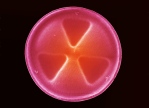‘Scanning Electron Microscope’
1980 – Switzerland
If a needle charged with electricity is placed extremely close to the surface of a metal or semi-conductor a miniscule but measurable electric current, known as a ‘tunneling current’ will leap the gap. This current is extraordinarily sensitive to the width of the gap. The size of the tunneling current therefore reveals the distance between the needle tip and the surface.
Related sites
scanning electron microscope (serc.carlton.edu/)
how-sem-works (nanoscience.com/)
high voltage electron microscopy (esi.nagoya-u.ac.jp)(2013)







 TIMELINE
TIMELINE